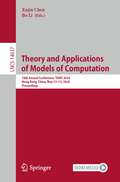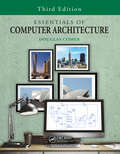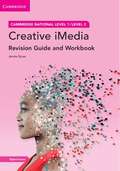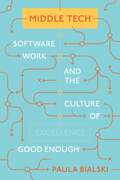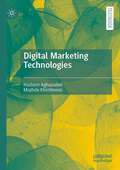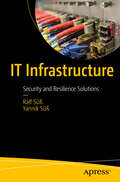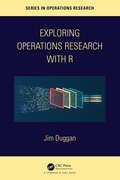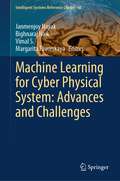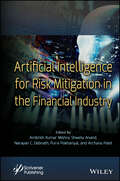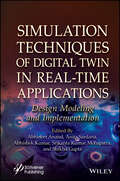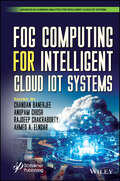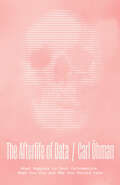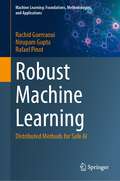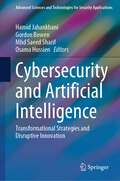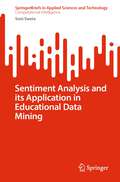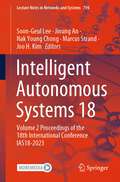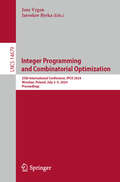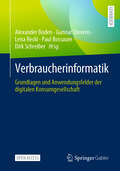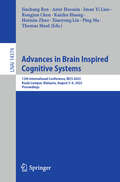- Table View
- List View
Theory and Applications of Models of Computation: 18th Annual Conference, TAMC 2024, Hong Kong, China, May 13–15, 2024, Proceedings (Lecture Notes in Computer Science #14637)
by Xujin Chen Bo LiThis book constitutes the proceedings of the 18th Annual Conference on Theory and Applications of Models of Computation, TAMC 2024, which was held in Hong Kong, China, during May 13–15, 2024. The 30 full papers presented in this book were carefully reviewed and selected from 69 submissions. The main themes of the selected papers are computability, complexity, algorithms, information theory, as well as their integration with machine learning theory and the foundations of artificial intelligence.
Essentials of Computer Architecture
by Douglas ComerThis easy-to-read textbook provides an introduction to computer architecture, focusing on the essential aspects of hardware that programmers need to know. Written from a programmer’s point of view, Essentials of Computer Architecture, Third Edition, covers the three key aspects of architecture: processors, physical and virtual memories, and input-output (I/O) systems.This third edition is updated in view of advances in the field. Most students only have experience with high-level programming languages, and almost no experience tinkering with electronics and hardware. As such, this text is revised to follow a top-down approach, moving from discussions on how a compiler transforms a source program into binary code and data, to explanations of how a computer represents data and code in binary.Additional chapters cover parallelism and data pipelining, assessing the performance of computer systems, and the important topic of power and energy consumption. Exclusive to this third edition, a new chapter explains multicore processors and how coherence hardware provides a consistent view of the values in memory even though each core has its own cache.Suitable for a one-semester undergraduate course, this clear, concise, and easy-to-read textbook offers an ideal introduction to computer architecture for students studying computer programming.
Essentials of Computer Architecture
by Douglas ComerThis easy-to-read textbook provides an introduction to computer architecture, focusing on the essential aspects of hardware that programmers need to know. Written from a programmer’s point of view, Essentials of Computer Architecture, Third Edition, covers the three key aspects of architecture: processors, physical and virtual memories, and input-output (I/O) systems.This third edition is updated in view of advances in the field. Most students only have experience with high-level programming languages, and almost no experience tinkering with electronics and hardware. As such, this text is revised to follow a top-down approach, moving from discussions on how a compiler transforms a source program into binary code and data, to explanations of how a computer represents data and code in binary.Additional chapters cover parallelism and data pipelining, assessing the performance of computer systems, and the important topic of power and energy consumption. Exclusive to this third edition, a new chapter explains multicore processors and how coherence hardware provides a consistent view of the values in memory even though each core has its own cache.Suitable for a one-semester undergraduate course, this clear, concise, and easy-to-read textbook offers an ideal introduction to computer architecture for students studying computer programming.
CAMBRIDGE NATIONAL LEVEL 1 / 2 Creative iMedia Revision Guide and Workbook: (pdf)
by Jennie EyresThis combined revision guide and workbook has been developed from extensive research with teachers. It covers the externally assessed unit of the qualification and helps students to prepare and practise for the exam. Divided into three distinct and easy-to-follow sections: Preparing for the exam; Revision pages; and Workbook practice pages, the revision guide section provides an easily accessible summary of content, while practice questions in the workbook section enable students to apply their knowledge and understanding. It provides clear and concise summaries of key learning points, with a strong visual presentation, to help focus students’ attention. Write-in activities support consolidation of learning and encourage active revision. Confidence-building activities help students to unlock the language of assessment and achieve their potential. Comes with full digital support to help students check knowledge and understanding, and to learn what to expect from different types of exam questions.
Middle Tech: Software Work and the Culture of Good Enough (Princeton Studies in Culture and Technology #36)
by Paula BialskiWhy software isn&’t perfect, as seen through the stories of software developers at a run-of-the-mill tech companyContrary to much of the popular discourse, not all technology is seamless and awesome; some of it is simply &“good enough.&” In Middle Tech, Paula Bialski offers an ethnographic study of software developers at a non-flashy, non-start-up corporate tech company. Their stories reveal why software isn&’t perfect and how developers communicate, care, and compromise to make software work—or at least work until the next update. Exploring the culture of good enoughness at a technology firm she calls &“MiddleTech,&” Bialski shows how doing good-enough work is a collectively negotiated resistance to the organizational ideology found in corporate software settings.The truth, Bialski reminds us, is that technology breaks due to human-related issues: staff cutbacks cause media platforms to crash, in-car GPS systems cause catastrophic incidents, and chatbots can be weird. Developers must often labor to patch and repair legacy systems rather than dream up killer apps. Bialski presents a less sensationalist, more empirical portrait of technology work than the frequently told Silicon Valley narratives of disruption and innovation. She finds that software engineers at MiddleTech regard technology as an ephemeral object that only needs to be good enough to function until its next iteration. As a result, they don&’t feel much pressure to make it perfect. Through the deeply personal stories of people and their practices at MiddleTech, Bialski traces the ways that workers create and sustain a complex culture of good enoughness.
Middle Tech: Software Work and the Culture of Good Enough (Princeton Studies in Culture and Technology #36)
by Paula BialskiWhy software isn&’t perfect, as seen through the stories of software developers at a run-of-the-mill tech companyContrary to much of the popular discourse, not all technology is seamless and awesome; some of it is simply &“good enough.&” In Middle Tech, Paula Bialski offers an ethnographic study of software developers at a non-flashy, non-start-up corporate tech company. Their stories reveal why software isn&’t perfect and how developers communicate, care, and compromise to make software work—or at least work until the next update. Exploring the culture of good enoughness at a technology firm she calls &“MiddleTech,&” Bialski shows how doing good-enough work is a collectively negotiated resistance to the organizational ideology found in corporate software settings.The truth, Bialski reminds us, is that technology breaks due to human-related issues: staff cutbacks cause media platforms to crash, in-car GPS systems cause catastrophic incidents, and chatbots can be weird. Developers must often labor to patch and repair legacy systems rather than dream up killer apps. Bialski presents a less sensationalist, more empirical portrait of technology work than the frequently told Silicon Valley narratives of disruption and innovation. She finds that software engineers at MiddleTech regard technology as an ephemeral object that only needs to be good enough to function until its next iteration. As a result, they don&’t feel much pressure to make it perfect. Through the deeply personal stories of people and their practices at MiddleTech, Bialski traces the ways that workers create and sustain a complex culture of good enoughness.
Digital Marketing Technologies
by Hashem Aghazadeh Mozhde KhoshnevisThis book argues that digital marketing should benefit from emerging technologies to result in sustainable competitive values for businesses in both the digital and physical worlds. It not only explores digital marketing fundamentals, analysis, strategy, practices, and implementation but also explains the applications and relationships of marketing technologies (martechs) with digital marketing; as well as offers several real cases of practicing marketing technologies. It carefully describes how modern businesses offer their value propositions both digitally and physically applying emerging technologies specifically marketing technologies (martechs) and how consumers are using these new technologies particularly artificial intelligence (ChatGPT/ OpenAI). It investigates why consumers are so intrigued and interested in digital relationships, interaction, and shopping experiences. It critically examines and argues that digital marketing has become popular among businesses as they areattempting to serve their customers better by taking advantage of using digital marketing technologies (marketchs).
IT Infrastructure: Security and Resilience Solutions
by Ralf Süß Yannik SüßEmbark on a comprehensive journey into the intricate world of IT infrastructure, with an in-depth look into the transformational role of secure, private data centers in today's digital era. This exploration uncovers the multi-faceted domains of IaaS, PaaS, and SaaS, examining the primary components of modern IT infrastructure—compute, storage, backup, and beyond. As technology continues to surge forward, cyber threats evolve in tandem, prompting a dire need for reinforced data center security and resilience.This book provides readers with a holistic, layered understanding of IT operations in our interconnected age. You will dive deep into the heart of technological advancements, appreciating the symbiotic relationship between evolving hardware capabilities and the progressive nature of cloud services. You will understand the intricacies of data center design, management, and the strategic role they play amid the growing reliance on both private and public clouds. Asindustries pivot towards a more digital-first approach, this book serves as a guiding star, illuminating the pathways, challenges, and opportunities of the vast IT infrastructure landscape.What You Will LearnTrace the rich history and evolution of data centers over the last 60 yearsGet comprehensive insights into cloud services architecture, from IaaS to SaaSGain in-depth knowledge of data center facilities, infrastructure, and securityKnow best practices in storage provisioning, administration, and cost managementDevelop strategies and tools for ensuring data center security and resilienceUnderstand the multi-faceted world of IT support service in modern digital environmentsWho This Book Is ForIT professionals: from system administrators and network architects to IT managers and data center overseers, plus students and tech enthusiasts seeking deep insights into IT infrastructure
Exploring Operations Research with R (Chapman & Hall/CRC Series in Operations Research)
by Jim DugganExploring Operations Research with R shows how the R programming language can be a valuable tool – and way of thinking – which can be successfully applied to the field of operations research (OR). This approach is centred on the idea of the future OR professional as someone who can combine knowledge of key OR techniques (e.g., simulation, linear programming, data science, and network science) with an understanding of R, including tools for data representation, manipulation, and analysis. The core aim of the book is to provide a self-contained introduction to R (both Base R and the tidyverse) and show how this knowledge can be applied to a range of OR challenges in the domains of public health, infectious disease, and energy generation, and thus provide a platform to develop actionable insights to support decision making.Features Can serve as a primary textbook for a comprehensive course in R, with applications in OR Suitable for post-graduate students in OR and data science, with a focus on the computational perspective of OR The text will also be of interest to professional OR practitioners as part of their continuing professional development Linked to a Github repository including code, solutions, data sets, and other ancillary material
Exploring Operations Research with R (Chapman & Hall/CRC Series in Operations Research)
by Jim DugganExploring Operations Research with R shows how the R programming language can be a valuable tool – and way of thinking – which can be successfully applied to the field of operations research (OR). This approach is centred on the idea of the future OR professional as someone who can combine knowledge of key OR techniques (e.g., simulation, linear programming, data science, and network science) with an understanding of R, including tools for data representation, manipulation, and analysis. The core aim of the book is to provide a self-contained introduction to R (both Base R and the tidyverse) and show how this knowledge can be applied to a range of OR challenges in the domains of public health, infectious disease, and energy generation, and thus provide a platform to develop actionable insights to support decision making.Features Can serve as a primary textbook for a comprehensive course in R, with applications in OR Suitable for post-graduate students in OR and data science, with a focus on the computational perspective of OR The text will also be of interest to professional OR practitioners as part of their continuing professional development Linked to a Github repository including code, solutions, data sets, and other ancillary material
Machine Learning for Cyber Physical System: Advances and Challenges (Intelligent Systems Reference Library #60)
by Janmenjoy Nayak Bighnaraj Naik Vimal S. Margarita FavorskayaThis book provides a comprehensive platform for learning the state-of-the-art machine learning algorithms for solving several cybersecurity issues. It is helpful in guiding for the implementation of smart machine learning solutions to detect various cybersecurity problems and make the users to understand in combating malware, detect spam, and fight financial fraud to mitigate cybercrimes. With an effective analysis of cyber-physical data, it consists of the solution for many real-life problems such as anomaly detection, IoT-based framework for security and control, manufacturing control system, fault detection, smart cities, risk assessment of cyber-physical systems, medical diagnosis, smart grid systems, biometric-based physical and cybersecurity systems using advance machine learning approach. Filling an important gap between machine learning and cybersecurity communities, it discusses topics covering a wide range of modern and practical advance machine learning techniques, frameworks, and development tools to enable readers to engage with the cutting-edge research across various aspects of cybersecurity.
Artificial Intelligence for Risk Mitigation in the Financial Industry
by Ambrish Kumar Mishra Shweta Anand Narayan C. Debnath Archana PatelArtificial Intelligence for Risk Mitigation in the Financial Industry This book extensively explores the implementation of AI in the risk mitigation process and provides information for auditing, banking, and financial sectors on how to reduce risk and enhance effective reliability. The applications of the financial industry incorporate vast volumes of structured and unstructured data to gain insight into the financial and non-financial performance of companies. As a result of exponentially increasing data, auditors and management professionals need to enhance processing capabilities while maintaining the effectiveness and reliability of the risk mitigation process. The risk mitigation and audit procedures are processes involving the progression of activities to “transform inputs into output.” As AI systems continue to grow mainstream, it is difficult to imagine an aspect of risk mitigation in the financial industry that will not require AI-related assurance or AI-assisted advisory services. AI can be used as a strong tool in many ways, like the prevention of fraud, money laundering, and cybercrime, detection of risks and probability of NPAs at early stages, sound lending, etc. Audience This is an introductory book that provides insights into the advantages of risk mitigation by the adoption of AI in the financial industry. The subject is not only restricted to individuals like researchers, auditors, and management professionals, but also includes decision-making authorities like the government. This book is a valuable guide to the utilization of AI for risk mitigation and will serve as an important standalone reference for years to come.
Simulation Techniques of Digital Twin in Real-Time Applications: Design Modeling and Implementation
by Abhineet Anand Anita Sardana Abhishek Kumar Srikanta Kumar Mohapatra Shikha GuptaSIMULATION TECHNIQUES OF DIGITAL TWIN IN REAL-TIME APPLICATIONS The book gives a complete overview of implementing digital twin technology in real-time scenarios while emphasizing how this technology can be embedded with running technologies to solve all other issues. Divided into two parts with Part 1 focusing on simulated techniques in digital twin technology and Part 2 on real-time applications of digital twin technology, the book collects a significant number of important research articles from domain-specific experts. The book sheds light on the various techniques of digital twin technology that are implemented in various application areas. It emphasizes error findings and respective solutions before the actual event happens. Most of the features in the book are on the implementation of strategies in real-time applications. Various real-life experiences are taken to show the proper implementation of simulation technologies. The book shows how engineers of any technology can input their research ideas to convert to real scenarios by using replicas. Hence, the book has a collection of research articles from various engineers with expertise in different technologies from many regions of the world. It shows how to implement the embedded real-time data into technologies. Specifically, the chapters relate to the auto landing and cruising features in aerial vehicles, automated coal mining simulation strategy, the enhancement of workshop equipment, and implementation in power energy management for urban railways. This book also describes the coherent mechanism of digital twin technologies with deep neural networks and artificial intelligence. Audience Researchers, engineers, and students in computer science, software engineering and industrial engineering, will find this book to be very useful.
Fog Computing for Intelligent Cloud IoT Systems (Advances in Learning Analytics for Intelligent Cloud-IoT Systems)
by Chandan Banerjee Anupam Rajdeep Chakraborty Ahmed A. ElngarFOG COMPUTING FOR INTELLIGENT CLOUD IOT SYSTEMS This book is a comprehensive guide on fog computing and how it facilitates computing, storage, and networking services Fog computing is a decentralized computing structure that connects data, devices, and the cloud. It is an extension of cloud computing and is an essential concept in IoT (Internet of Things), as it reduces the burden of processing in cloud computing. It brings intelligence and processing closer to where the data is created and transmitted to other sources. Fog computing has many benefits, such as reduced latency in processing data, better response time that helps the user’s experience, and security and privacy compliance that assures protecting the vital data in the cloud. It also reduces the cost of bandwidth, because the processing is achieved in the cloud, which reduces network bandwidth usage and increases efficiency as user devices share data in the local processing infrastructure rather than the cloud service. Fog computing has various applications across industries, such as agriculture and farming, the healthcare industry, smart cities, education, and entertainment. For example, in the agriculture industry, a very prominent example is the SWAMP project, which stands for Smart Water Management Platform. With fog computing’s help, SWAMP develops a precision-based smart irrigation system concept used in agriculture, minimizing water wastage. This book is divided into three sections. The first section studies fog computing and machine learning, covering fog computing architecture, application perspective, computational offloading in mobile cloud computing, intelligent Cloud-IoT systems, machine learning fundamentals, and data visualization. The second section focuses on applications and analytics, spanning various applications of fog computing, such as in healthcare, Industry 4.0, cancer cell detection systems, smart farming, and precision farming. This section also covers analytics in fog computing using big data and patient monitoring systems, and the emergence of fog computing concerning applications and potentialities in traditional and digital educational systems. Security aspects in fog computing through blockchain and IoT, and fine-grained access through attribute-based encryption for fog computing are also covered. Audience The book will be read by researchers and engineers in computer science, information technology, electronics, and communication specializing in machine learning, deep learning, the cyber world, IoT, and security systems.
The Afterlife of Data: What Happens to Your Information When You Die and Why You Should Care
by Carl ÖhmanA short, thought-provoking book about what happens to our online identities after we die. These days, so much of our lives takes place online—but what about our afterlives? Thanks to the digital trails that we leave behind, our identities can now be reconstructed after our death. In fact, AI technology is already enabling us to “interact” with the departed. Sooner than we think, the dead will outnumber the living on Facebook. In this thought-provoking book, Carl Öhman explores the increasingly urgent question of what we should do with all this data and whether our digital afterlives are really our own—and if not, who should have the right to decide what happens to our data. The stakes could hardly be higher. In the next thirty years alone, about two billion people will die. Those of us who remain will inherit the digital remains of an entire generation of humanity—the first digital citizens. Whoever ends up controlling these archives will also effectively control future access to our collective digital past, and this power will have vast political consequences. The fate of our digital remains should be of concern to everyone—past, present, and future. Rising to these challenges, Öhman explains, will require a collective reshaping of our economic and technical systems to reflect more than just the monetary value of digital remains. As we stand before a period of deep civilizational change, The Afterlife of Data will be an essential guide to understanding why and how we as a human race must gain control of our collective digital past—before it is too late.
The Afterlife of Data: What Happens to Your Information When You Die and Why You Should Care
by Carl ÖhmanA short, thought-provoking book about what happens to our online identities after we die. These days, so much of our lives takes place online—but what about our afterlives? Thanks to the digital trails that we leave behind, our identities can now be reconstructed after our death. In fact, AI technology is already enabling us to “interact” with the departed. Sooner than we think, the dead will outnumber the living on Facebook. In this thought-provoking book, Carl Öhman explores the increasingly urgent question of what we should do with all this data and whether our digital afterlives are really our own—and if not, who should have the right to decide what happens to our data. The stakes could hardly be higher. In the next thirty years alone, about two billion people will die. Those of us who remain will inherit the digital remains of an entire generation of humanity—the first digital citizens. Whoever ends up controlling these archives will also effectively control future access to our collective digital past, and this power will have vast political consequences. The fate of our digital remains should be of concern to everyone—past, present, and future. Rising to these challenges, Öhman explains, will require a collective reshaping of our economic and technical systems to reflect more than just the monetary value of digital remains. As we stand before a period of deep civilizational change, The Afterlife of Data will be an essential guide to understanding why and how we as a human race must gain control of our collective digital past—before it is too late.
Robust Machine Learning: Distributed Methods for Safe AI (Machine Learning: Foundations, Methodologies, and Applications)
by Rachid Guerraoui Nirupam Gupta Rafael PinotToday, machine learning algorithms are often distributed across multiple machines to leverage more computing power and more data. However, the use of a distributed framework entails a variety of security threats. In particular, some of the machines may misbehave and jeopardize the learning procedure. This could, for example, result from hardware and software bugs, data poisoning or a malicious player controlling a subset of the machines. This book explains in simple terms what it means for a distributed machine learning scheme to be robust to these threats, and how to build provably robust machine learning algorithms. Studying the robustness of machine learning algorithms is a necessity given the ubiquity of these algorithms in both the private and public sectors. Accordingly, over the past few years, we have witnessed a rapid growth in the number of articles published on the robustness of distributed machine learning algorithms. We believe it is time to provide a clear foundation to this emerging and dynamic field. By gathering the existing knowledge and democratizing the concept of robustness, the book provides the basis for a new generation of reliable and safe machine learning schemes. In addition to introducing the problem of robustness in modern machine learning algorithms, the book will equip readers with essential skills for designing distributed learning algorithms with enhanced robustness. Moreover, the book provides a foundation for future research in this area.
Cybersecurity and Artificial Intelligence: Transformational Strategies and Disruptive Innovation (Advanced Sciences and Technologies for Security Applications)
by Hamid Jahankhani Gordon Bowen Mhd Saeed Sharif Osama HussienThis book discusses a range of topics that are essential to understanding cyber security, including legal implications and technical aspects, cyber detection, and minimising the threats so that governments and organisations can function without noticeable degradation of service. Unlike other technological threats, cyber security threats have the potential to destroy governments and undermine democratic processes – which makes an overarching cyber security strategy essential for all functioning governments. Thus, the book serves as a guide for developing strategies and ideas in the field and as a motivator for other governments and interested parties to develop and implement effective strategies. Arguably the most difficult aspect of these strategies is their implementation, which will require a cultural sea change in governments’ approaches to handling cyber security and developing a regulatory framework that links organisations and governments in a secure working environment. The development of cyber security strategies calls for new skills at the technical and user levels alike. However, IT skills are sometimes in short supply, and without a government policy on cyber security training, the lack of these skills could hamper the full potential of cyber security. The book explores various aspects and challenges of cyber security strategy and highlights the benefits and drawbacks, offering in-depth insights into the field.
Sentiment Analysis and its Application in Educational Data Mining (SpringerBriefs in Applied Sciences and Technology)
by Soni SwetaThe book delves into the fundamental concepts of sentiment analysis, its techniques, and its practical applications in the context of educational data. The book begins by introducing the concept of sentiment analysis and its relevance in educational settings. It provides a thorough overview of the various techniques used for sentiment analysis, including natural language processing, machine learning, and deep learning algorithms. The subsequent chapters explore applications of sentiment analysis in educational data mining across multiple domains. The book illustrates how sentiment analysis can be employed to analyze student feedback and sentiment patterns, enabling educators to gain valuable insights into student engagement, motivation, and satisfaction. It also examines how sentiment analysis can be used to identify and address students' emotional states, such as stress, boredom, or confusion, leading to more personalized and effective interventions. Furthermore, the book explores the integration of sentiment analysis with other educational data mining techniques, such as clustering, classification, and predictive modeling. It showcases real-world case studies and examples that demonstrate how sentiment analysis can be combined with these approaches to improve educational decision-making, curriculum design, and adaptive learning systems.
Intelligent Autonomous Systems 18: Volume 2 Proceedings of the 18th International Conference IAS18-2023 (Lecture Notes in Networks and Systems #794)
by Soon-Geul Lee Jinung An Nak Young Chong Marcus Strand Joo H. KimIntelligent autonomous systems are increasingly being applied in various fields, ranging from industrial applications to professional services and household domains. These advancements in technology and application domains have brought forth the need for continuous research and development to address new challenges in deploying intelligent autonomous systems in a reliable and user-independent manner This book is a compilation that aims to serve researchers and practitioners in related fields by providing a timely dissemination of recent progress in the areas of autonomous mobility and robotics. The contents of this book are based on a collection of papers presented at the 18th International Conference on Intelligent Autonomous Systems (IAS18 2023), held at the Suwon Convention Center in Suwon, Korea. The conference took place fully in person from July 4 to 7, 2023, with the theme “Impact and Effect of AI on Intelligent Autonomous Systems.” It encompassed discussions on theories, applications, and creative innovations in intelligent autonomous systems, covering topics such as autonomous vehicles, intelligent agents, smart sensors and actuators, smart haptics, human–machine interaction, digital twin, digital health, and metaverse, VR, AR, or MR. For ease of reading, the 91 papers have been grouped into five chapters: Chapter 1: Intelligent Autonomous Vehicles; Chapter 2: Autonomous Robots; Chapter 3: Intelligent Perception and Sensors; Chapter 4: Data Fusion and Machine Learning for Intelligent Robots; and Chapter 5: Applied Autonomous Systems. The articles included in this book underwent a rigorous peer-review process and were presented at the IAS18-2023 conference. For researchers working in the field of intelligent autonomous systems technology, we believe this book provides valuable insights into recent advances in autonomous technologies and applications, thereby enriching their studies. We extend our heartfeltthanks to all the authors and editors who contributed to this edition.
Integer Programming and Combinatorial Optimization: 25th International Conference, IPCO 2024, Wroclaw, Poland, July 3–5, 2024, Proceedings (Lecture Notes in Computer Science #14679)
by Jens Vygen Jarosław ByrkaThis book constitutes the refereed proceedings of the 25th International Conference on Integer Programming and Combinatorial Optimization, IPCO 2024, held in Wrocław, Poland, during July 3–5, 2024. The 33 full papers presented were carefully reviewed and selected from 101 submissions. IPCO is under the auspices of the Mathematical Optimization Society, and it is an important forum for presenting present recent developments in theory, computation, and applications. The scope of IPCO is viewed in a broad sense, to include algorithmic and structural results in integer programming and combinatorial optimization as well as revealing computational studies and novel applications of discrete optimization to practical problems.
Verbraucherinformatik: Grundlagen und Anwendungsfelder der digitalen Konsumgesellschaft
by Alexander Boden Gunnar Stevens Lena Recki Paul Bossauer Dirk SchreiberIn einer Zeit, in der digitale Technologien nahezu jeden Aspekt unseres Lebens durchdringen, ist es unerlässlich, die tieferen Zusammenhänge des digitalen Konsums zu verstehen. Erstmalig bietet dieses open access-Lehrbuch einen Wegweiser durch die vielfältigen Facetten der Digitalisierung des Konsums. Dabei verbindet es die Disziplinen der angewandten Informatik und Verbraucherwissenschaften. Die Leserinnen und Leser erhalten Einblick in die digitale Konsumlandschaft, ausgehend von der historischen Entwicklung des (digitalen) Konsums. Dazu vermittelt das Lehrbuch zentrale Grundbegriffe und Themen der Verbraucherinformatik und stellt verschiedene Konsumtheorien aus den Disziplinen Wirtschaftswissenschaften, Psychologie und Sozialwissenschaften vor. Praxisnahe Beispiele aus der Digitalisierung bieten Einsichten in unterschiedliche Perspektiven, während vertiefende Textboxen und Selbstreflexionsfragen das Verständnis fördern. Inhaltlich decken die Autorinnen und Autoren Themen von Datenschutz bis zur Sharing Economy ab und geben insbesondere auch praktische Ansätze für Themen wie Verbraucherschutz und Nachhaltigkeit mit auf den Weg. Die Anwendungs- und Querschnittsthemen der Verbraucherinformatik reichen von der Digitalisierung der Haushalte und Märkte über Fragen des digitalen Verbraucherschutzes bis hin zu zentralen gesellschaftlichen Fragestellungen rund um die Themen Fairness, Verantwortung und Nachhaltigkeit bei der Gestaltung von digitalen Technologien. Das Buch bietet einen umfassenden Überblick, der sowohl für Studierende der Wirtschafts- und Sozialwissenschaften als auch der angewandten Informatik von bedeutendem Wert ist.
Advances in Brain Inspired Cognitive Systems: 13th International Conference, BICS 2023, Kuala Lumpur, Malaysia, August 5–6, 2023, Proceedings (Lecture Notes in Computer Science #14374)
by Jinchang Ren Amir Hussain Iman Yi Liao Rongjun Chen Kaizhu Huang Huimin Zhao Xiaoyong Liu Ping Ma Thomas MaulThis book constitutes the refereed proceedings of the International Conference on Brain Inspired Cognitive Systems, BICS 2023, held in Kuala Lumpur, Malaysia, in August 2023. The 36 full papers included in this book were reviewed and selected from 58 submissions and are organized in thematic sections as follows: Bio-inspired systems and Neural Computation; Image Recognition, Detection and Classification; Vision and Object Tracking; Data Analysis and Machine Learning and Applications.
New Horizons for Fuzzy Logic, Neural Networks and Metaheuristics (Studies in Computational Intelligence #1149)
by Oscar Castillo Patricia MelinThis book contains a collection of papers focused on hybrid intelligent systems based on soft computing techniques. In this book, new horizons on the theoretical developments of fuzzy logic, neural networks and optimization algorithms are envisioned. In addition, the abovementioned methods are discussed in application areas such as control and robotics, pattern recognition, medical diagnosis, decision-making, prediction and optimization of complex problems. There are a group of papers with the main theme of type-1, type-2 and type-3 fuzzy systems, which basically consists of papers that propose new concepts and algorithms based on type-1, type-2 and type-3 fuzzy logic and their applications. There is also a group of papers that offer theoretical concepts and applications of meta-heuristics in different areas. Another group of papers outlines diverse applications of hybrid intelligent systems in real problems. There are also a group papers that present theory and practice of neural networks in different applications. Finally, there are papers that offer theory and practice of optimization and evolutionary algorithms in different application areas.
CompTIA Security+ Practice Tests: Exam SY0-701 (Sybex Study Guide Ser.)
by David SeidlPrepare for the Security+ certification exam confidently and quickly CompTIA Security+ Practice Tests: Exam SY0-701, Third Edition, prepares you for the newly updated CompTIA Security+ exam. You'll focus on challenging areas and get ready to ace the exam and earn your Security+ certification. This essential collection of practice tests contains study questions covering every single objective domain included on the SY0-701. Comprehensive coverage of every essential exam topic guarantees that you'll know what to expect on exam day, minimize test anxiety, and maximize your chances of success. You'll find 1000 practice questions on topics like general security concepts, threats, vulnerabilities, mitigations, security architecture, security operations, and security program oversight. You'll also find: Complimentary access to the Sybex test bank and interactive learning environment Clear and accurate answers, complete with explanations and discussions of exam objectives Material that integrates with the CompTIA Security+ Study Guide: Exam SY0-701, Ninth Edition The questions contained in CompTIA Security+ Practice Tests increase comprehension, strengthen your retention, and measure overall knowledge. It's an indispensable part of any complete study plan for Security+ certification. And save 10% when you purchase your CompTIA exam voucher with our exclusive WILEY10 coupon code.
